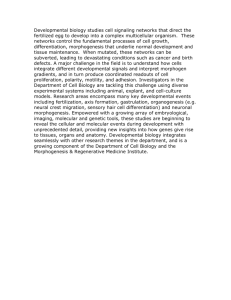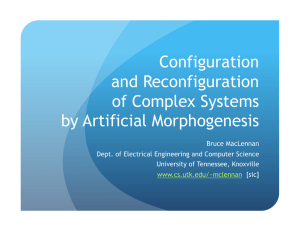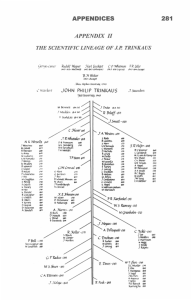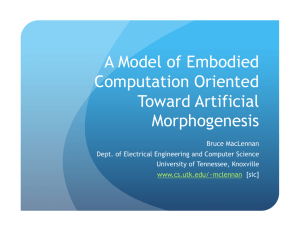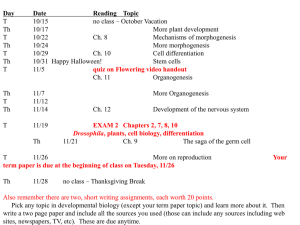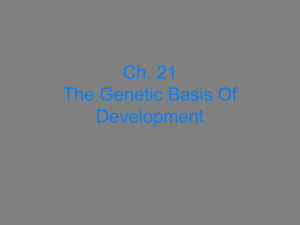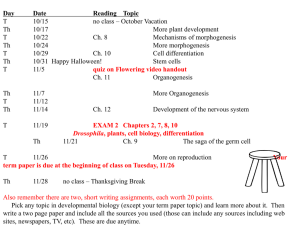Embodied Computation Applying the Physics of Computation to Artificial Morphogenesis
advertisement
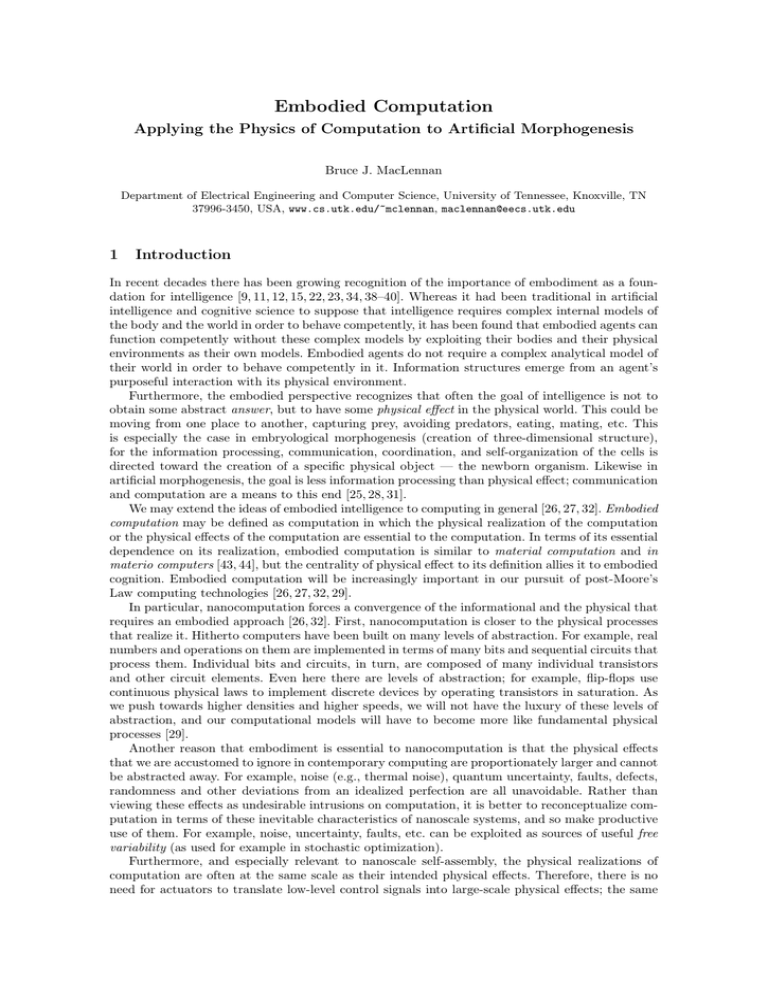
Embodied Computation Applying the Physics of Computation to Artificial Morphogenesis Bruce J. MacLennan Department of Electrical Engineering and Computer Science, University of Tennessee, Knoxville, TN 37996-3450, USA, www.cs.utk.edu/~mclennan, maclennan@eecs.utk.edu 1 Introduction In recent decades there has been growing recognition of the importance of embodiment as a foundation for intelligence [9, 11, 12, 15, 22, 23, 34, 38–40]. Whereas it had been traditional in artificial intelligence and cognitive science to suppose that intelligence requires complex internal models of the body and the world in order to behave competently, it has been found that embodied agents can function competently without these complex models by exploiting their bodies and their physical environments as their own models. Embodied agents do not require a complex analytical model of their world in order to behave competently in it. Information structures emerge from an agent’s purposeful interaction with its physical environment. Furthermore, the embodied perspective recognizes that often the goal of intelligence is not to obtain some abstract answer, but to have some physical effect in the physical world. This could be moving from one place to another, capturing prey, avoiding predators, eating, mating, etc. This is especially the case in embryological morphogenesis (creation of three-dimensional structure), for the information processing, communication, coordination, and self-organization of the cells is directed toward the creation of a specific physical object — the newborn organism. Likewise in artificial morphogenesis, the goal is less information processing than physical effect; communication and computation are a means to this end [25, 28, 31]. We may extend the ideas of embodied intelligence to computing in general [26, 27, 32]. Embodied computation may be defined as computation in which the physical realization of the computation or the physical effects of the computation are essential to the computation. In terms of its essential dependence on its realization, embodied computation is similar to material computation and in materio computers [43, 44], but the centrality of physical effect to its definition allies it to embodied cognition. Embodied computation will be increasingly important in our pursuit of post-Moore’s Law computing technologies [26, 27, 32, 29]. In particular, nanocomputation forces a convergence of the informational and the physical that requires an embodied approach [26, 32]. First, nanocomputation is closer to the physical processes that realize it. Hitherto computers have been built on many levels of abstraction. For example, real numbers and operations on them are implemented in terms of many bits and sequential circuits that process them. Individual bits and circuits, in turn, are composed of many individual transistors and other circuit elements. Even here there are levels of abstraction; for example, flip-flops use continuous physical laws to implement discrete devices by operating transistors in saturation. As we push towards higher densities and higher speeds, we will not have the luxury of these levels of abstraction, and our computational models will have to become more like fundamental physical processes [29]. Another reason that embodiment is essential to nanocomputation is that the physical effects that we are accustomed to ignore in contemporary computing are proportionately larger and cannot be abstracted away. For example, noise (e.g., thermal noise), quantum uncertainty, faults, defects, randomness and other deviations from an idealized perfection are all unavoidable. Rather than viewing these effects as undesirable intrusions on computation, it is better to reconceptualize computation in terms of these inevitable characteristics of nanoscale systems, and so make productive use of them. For example, noise, uncertainty, faults, etc. can be exploited as sources of useful free variability (as used for example in stochastic optimization). Furthermore, and especially relevant to nanoscale self-assembly, the physical realizations of computation are often at the same scale as their intended physical effects. Therefore, there is no need for actuators to translate low-level control signals into large-scale physical effects; the same physical processes that realize the computation may constitute its physical effect. At the nanoscale, computation may be truly embodied in that input and output transduction is unnecessary [26]. 2 Embodied Computation in Morphogenesis Proteins are fundamental agents of embodied computation, because they are the nexus of informational and physical processes in living things. The function of a protein, of course, depends primarily on its shape, on the chemical groups that are thus hidden or exposed, and on its resulting affinities, but also on the protein’s dynamical properties. A protein’s physical structure is determined by its amino acid sequence, which is encoded in DNA and transcribed into RNA. The resulting polypeptide sequence folds up into a complex three-dimensional shape with characteristic mechanical, chemical, and other physical properties relevant to its function in the organism. In this case we have a fairly direct relationship between an information structure, as encoded in the DNA, and a functional physical structure (the protein molecule). The DNA is not some abstract blueprint for the protein’s physical structure, but by its translation into a polypeptide sequence it self-organizes into a physical structure. Fundamental to embodied computation at the cellular level are allosteric proteins, which have multiple conformations with different functions, and can be switched between these conformations by binding regulatory molecules [8, pp. 63–5, 78–9]. In these cases the information processing function — the decision to function in different ways depending on the regulatory input — is realized directly by the change in protein shape cause by the regulatory molecule. Some allosteric proteins have nine regulatory sites and can respond to various combinations of regulators, implementing hierarchical regulation, making these proteins more complex than simple switches [8, pp. 63–5, 78–9]. Tissues — masses of functionally related cells — are higher-level media of embodied computation in multicellular organisms. During embryological morphogenesis cells interact primarily in two kinds of tissue, mesenchyme and epithelium, which often interact in pairs [16, pp. 16, 21]. Mesenchyme is a tissue in which largely unattached cells are suspended or migrate through a three-dimensional extracellular matrix composed of proteins, polysaccharides, and other nonliving substances. It is viscoelastic “soft matter” through which cells can move and morphogens can diffuse [17, p. 3]. In contrast to mesenchyme, cells may be tightly bound into sheets, called epithelia. Typically the cells are arranged in a polarized orientation, bound side to side, with their apical ends forming a tight seal on one side of the sheet, and their basal ends, on the other side, contacting an extracellular matrix, often in the form of a basement membrane [16, p. 68]. Although the cells are bound together, they are still able to move relatively to each other, which is an important morphogenetic mechanism [16, pp. 71–8]. Epithelia are essential vehicles for morphogenesis, for as they fold, stretch, and deform in other ways, they bring different cells and tissues in contact with each other, triggering further morphogenetic processes [16, pp. 71–8]. Among other functions, epithelia confine cell migration and morphogen diffusion, thus altering the progress of morphogenesis. Also essential to morphogenesis are epithelial-mesenchymal transformations, in which mesenchyme may condense into an epithelium, or an epithelium “dissolves” and disperses into mesenchyme [16, pp. 67–71]. 3 3.1 Artificial Morphogenesis Morphogenesis as Embodied Computation Embryological development uses molecular interactions to regulate and coordinate morphogenesis in order to generate complex hierarchical systems, organized from the nanoscale up through the macroscale. Our goal is to understand this process as embodied computation, so that we can identify which physical relationships are essential to it, in order to realize them in different, artificial self-assembling systems. In particular, this will help us to understand how to exploit molecular coordination at the nanoscale in order to realize complex embodied computation. For example, we know that diffusion is an important means of signaling and coordination in development, for it can broadcast information through a region, or establish gradients that create patterns. In many cases the particular molecules that diffuse are not so important as more abstract properties: that they can be produced and detected by the agents, and that they have certain relative diffusion and degradation rates relative to other processes. Nevertheless, physical diffusion is a process that can be profitably exploited at the nanoscale, and so we should learn how to use it. A closely related process occurs when a sufficiently stimulated cell produces a signal that stimulates nearby cells. This causes a wave of activity to propagate through the medium. Examples of such excitable media are found in the propagation of neural action potentials [18], the aggregation of the slime mold Dictyostelium discoideum [24, 37], and the clock-and-wavefront model of somitogenesis [13, 14, 20], among others. Excitable media can be implemented in many different ways, and so they can be implemented in many systems for the purposes of morphogenesis. Chemotaxis is also an important morphogenetic mechanism, which can be implemented by a variety of means. All that is required is the establishment of a gradient — perhaps by diffusion of a signal molecule — and an agent capable of moving up or down the gradient. Whether the gradient is of molecular concentration, of adhesion, of electrical charge, or of something else matters only insofar as the agent can follow it on the intended length scale. In general terms our approach is to take natural morphogenetic processes, express them mathematically (if not already done in the literature), and understand them in general physical terms (e.g., diffusion, adhesion, attraction, stress, pressure). This abstract description is the essence of the embodied computation, which can then be realized by other physical systems conforming to the mathematical description (which constitutes, in effect, a morphogenetic “program”). Even models that have been rejected as explanations of morphogenesis in embryos may be useful in artificial systems, if they have the correct dynamical behavior. In general, artificial morphogenesis can be considered a species of amorphous computing [1], but — especially after the morphogenetic process has progressed — it is anything but amorphous. Indeed, it is prior forms that create the conditions that govern the creation of later forms. There has, of course, been much work in the computational modeling of natural morphogenesis, but the goal of our research is nanotechnological. Other researchers have addressed similar goals, for example in the context of reconfigurable robotics, and sometimes inspired by morphogenesis [19, 35, 36], but in our opinion they have not taken full advantage of developmental science nor faced up to the problem of very large numbers of agents (hundreds of thousands to hundreds of millions). 3.2 Natural vs. Artificial Morphogenesis Depending on the realization medium, there may be significant differences between natural and artificial morphogenesis. Of course, if genetically-engineered organisms are used for artificial morphogenesis, then the differences from natural morphogenesis might not be great, but in this paper we will focus on artificial agents that may use biological materials but are not living organisms. Therefore we must consider the way that morphogenetic processes need to be adapted for artificial agents. Among the primary processes of morphogenesis, Edelman lists three driving forces [16, p. 17]. The first is cell proliferation, which results from cell division, and is the principal means by which tissues increase in size. However, at this time we do not have a feasible means of making selfreproducing artificial agents, and so proliferation must be accomplished by different means in artificial morphogenesis. One approach is to provide a supply of new (or recycled) agents, but they will need a path to proliferation sites, which creates additional problems. It is difficult to tell at this time whether this problem will be a minor difference between natural and artificial morphogenesis, or whether it will dictate wholly new approaches in artificial systems. Fortunately, simulations will be useful in determining alternative approaches to cell division. Another driving force is programmed cell death (apoptosis), that is, cell elimination. which is one of the most important processes for sculpting tissues and for fine-tuning structure (as in the nervous system). Artificial analogues are much more feasible than for cell division, since it is easy to imagine mechanisms by which artificial agents inactivate and even disassemble themselves. However, the end products may be less amenable to reabsorption or recycling than natural substances, but this does not seem to be an insurmountable problem. Again, simulations will allow alternative approaches to be explored. The third driving force is cell migration, and the principal means by which cells move during morphogenesis is by changing shape (e.g., by extending lamellipodia) and controlling their adhesion to other cells and to the extracellular matrix. Adhesion is implemented by a variety of cell adhesion molecules (CAMs) and substrate adhesion molecules (SAMs), which are deployed on the cell membrane in an orchestrated but stochastic manner [16, ch. 7]. It seems unlikely that artificial agents will have a comparable flexible shape, or the variety of CAMs and SAMs or flexibility in deploying them. However it is plausible that migration of artificial agents will be primarily be means of control of local adhesion. But we may have to adapt some morphogenetic processes to accommodate artificial agents with more limited locomotive abilities than their natural counterparts. Electrostatic adhesion is another possibility [19], but it does not have the specificity of molecular adhesion, which may be crucial for morphogenesis. In addition to the driving forces, Edelman includes two regulatory processes among the primary morphogenetic processes. The first regulatory process is differentiation, by which a cell changes its genetic expression and thereby becomes more specialized in its function. There are several ways that artificial morphogenetic agents can accomplish the same purpose. Obviously, any computational system can have multiple internal control states that regulate its operation, and this is the direct analogue of cell differentiation. Protein and genetic regulatory circuits in cells correspond in many ways to electrical circuits [8, 7]. However, internal states occupy physical resources, and artificial microscopic agents might have limited internal state spaces. Natural morphogenesis operates with genetically identical cells descended from a single cell. (An exception would be the quasi-morphogenetic assembly of genetically diverse slime mold amoebae into an organized “slug.”) However, artificial morphogenetic processes are not constrained in this way. Since proliferation cannot be implemented through self-reproduction, but requires an external source of new agents, therefore differentiation can be handled by providing agents of different kinds. However, this does require a change in morphogenetic processes, since instead of agents differentiating in situ, already specialized agents will have to find their way to their destinations from outside the tissue. In practice, we expect that artificial morphogenesis will make use of both processes, with specialized agents further differentiating by change of internal state. The second regulatory process is adhesion, both cell to cell and cell to substrate. Adhesion has mechanical functions, as a basis of cell motion and of both elastic and rigid tissues, but adhesive molecules also provide signals regulating differentiation, epithelial-mesenchymal transformations, etc. Therefore we must consider how analogous functions can be accomplished with artificial agents. For example, temporary adhesion, especially for purposes of migration, might be implemented by electrostatic or magnetic actuators [19]. The same would apply to epithelial-mesenchymal transformations. More permanent adhesion could be implemented by mechanical latching [41]. The extracellular matrix is the medium through which mesenchymal cells move, it is a medium through which morphogens diffuse, and it provides a substrate to which cells adhere — all important functions in artificial morphogenesis as well. Furthermore, although active agents (cells or microrobots) are often the medium of morphogenetic self-assembly, agents may also arrange inactive components and substances as part of the final structure. Non-living agents may be less capable of producing these substances than living cells, and so in some applications we will have to find alternative solutions. For example, rather than having agents produce materials in situ, they may have to go and transport them from an external supply, or bring them along when they are arriving externally in lieu of in situ reproduction. Which solution is most appropriate will depend on the details of the morphogenetic process, including the relative quantities of material involved. Cells have flexible membranes and, by controlling their cytoskeletons, are able to change shape in a variety of ways; they are also able to redistribute the adhesive molecules on their membranes. These capabilities are important for contraction, differential adhesion, and other morphogenetic processes. Although artificial agents may have similar capabilities, we expect them to be less extensive and less flexible. It is difficult to evaluate the effect of these differences without the capabilities of a specific implementation medium in mind, although some of the possibilities may be explored through simulation. 3.3 Levels of Description Biologists use a variety of means to describe morphogenetic processes, including mathematical equations, agent-based models, and qualitative descriptions, such as influence diagrams [6, 46]. To enable the development of artificial morphogenesis, we have been developing and evaluating a formal notation, which can be thought of as a kind of programming language, oriented toward artificial morphogenesis [28, 30, 25, 31] (see Sect. 4 for examples). Morphogenetic agents are discrete (e.g., cells or microrobots), but — especially in the context of complex, hierarchically structured systems — the numbers of agents are so large that it is generally convenient to treat them as a continuum. Biologists often make use of partial differential equations and continuum mechanics to describe these processes [17, 33, 5, 45], and we have found this to be a useful mathematical framework. One advantage of a continuum approach over more agent-based models is that it ensures that our morphogenetic processes scale up to very large numbers of very small agents, for in the continuum limit we have an infinite number of infinitesimal agents. We take this to be an advantage over some other approaches to self-assembly, programmable matter, etc. that have been demonstrated (generally in simulation) for modest numbers of agents (generally, at most hundreds), but do not obviously scale up to very large numbers (tens of thousands to millions or more). Nevertheless, it is sometimes more convenient to treat tissues as collectives of discrete agents. One reason is that there may be small-sample effects when the density of agents is low, and in these cases it may be better to treat the agents from the perspective of statistical mechanics. Another reason is that it is sometimes more intuitive to describe behavior from an agent-oriented perspective, that is, a cell- or robot-eye view [6]. Our approach to this issue is to use a material (Lagrangian) reference frame, as opposed to a spatial (Eulerian) frame [28, 30, 25, 31]. We are also developing formal tools to help us negotiate the borderlands where the continuum approximation is not appropriate [28, 25]. In general, in our development of techniques and notation, we are attempting to maintain complementary perspectives, so that continuum methods also apply to large numbers of spatially organized discrete elements. More specifically, the requirements of complementarity have dictated a different spatial scale from some other approaches to describing morphogenesis. For example, CompuCell3D models morphogenetic processes at a level below individual cells in order to be able to address changes in cell shape [10]. We, however, describe morphogenesis at a higher level, at which differential volume elements represent ensembles of agents. This requires some special approaches, described elsewhere [28, 30, 25, 31], for dealing with ensembles whose constituent agents might not all have the same values for their properties, and for dealing with properties such as shape and orientation. 3.4 Change Equations As have most biologists, we have found it most convenient to describe morphogenetic processes by means of differential equations. However, sometimes it is convenient to treat them as discretetime processes, for example, when they are simulated on a digital computer. Therefore, we have been experimenting with formal change equations, which have complementary interpretations as differential equations and finite difference equations. For example, the change equation - X = F (X, Y, . . .) D can be interpreted as a differential equation, ∂X/∂t = F (X, Y, . . .), or as a finite difference equation, ∆X/∆t = F (X, Y, . . .), where the time step ∆t is implicit in the notation. The formal rules for manipulating change equations respects their complementary continuous-time and discrete-time interpretations. 3.5 More and Less Specific Implementations Embodied computational processes can be more or less specific to particular physical realizations; they may depend on physical properties and processes that are more or less common. Therefore, in developing an embodied computational process we must decide how specific to a particular class of physical realizations we want it to be. For example, in morphogenesis, we do not want to tie ourselves to accomplishing things the same way as an embryo does. A more abstract description of the natural process may have alternative realizations that are just as effective but more suitable to artificial morphogenesis. For example, in embryological somitogenesis cell proliferation causes the embryo’s tail bud to recede from its head end because the new cells push them apart (see Sect. 4.2 below). However, for the purposes of somitogenesis all that matters is that the distance between the head region and tail bud increases while maintaining a constant cell density between them. One way to accomplish this is the way the embryo does, with cell division increasing the tissue volume and pushing the head and tail apart. But for artificial morphogenesis is might be more feasible to accomplish the same effect in a different way. For example, the tail bud agents could migrate away from the head, which would tend to decrease the agent density between the head and tail. The decrease in density could recruit agents from an external supply to join the intermediate tissue and restore the density to its nominal value. Here we have two more-specific realizations of one more-abstract embodied computational process. Analogous to the class and subclass structure in object-oriented programming languages, we can see that embodied computational processes, in morphogenesis and other applications, can be arranged in hierarchies of more or less specific physical behavior. As will be shown in the following examples, our morphogenetic programming notation defines substances in a similar class hierarchy. 4 Examples 4.1 Simple Diffusion To illustrate our experimental notation for artificial morphogenesis, we begin with a simple, familiar example, diffusion. The fundamental concept is a substance, which is a class of materials with common properties and behavior (analogous to a class in an object-oriented programming language). A morphogenetic program comprises a number of bodies or tissues, each an instance of a substance. (Bodies are analogous to the objects of object-oriented programming.) As in continuum mechanics, a body or tissue is treated as a continuum of material points, which undergoes deformation as a result of its dynamical laws [17, 45]. A fundamental property of every material point in a body is p, its position in three-dimensional space. Therefore, in the simplest case diffusion is defined by a stochastic differential equation governing the position of each point: - p = µ+σD - W. D Here µ is a vector field defining a drift velocity (perhaps caused externally) at each point in space; - W is an n-dimensional random vector (normally distributed with zero the Wiener derivative D mean and unit variance in each dimension), which is the source of n degrees of random variability (Brownian motion) for the particle; and σ is an 3 × n tensor field, which — at each point in space — describes three-dimensional diffusibility resulting from the sources of randomness. (Consistent complementary discrete and continuous interpretations of the above stochastic differential equation require that it be interpreted according to the Itō calculus, as explained elsewhere [28, 25, 31].) Our notation declares the fundamental variables (without specifying their values) and defines the behavior of the substance (here called morphogen): substance morphogen: vector field µ k drift velocity order-2 field(3 × n) σ k diffusion tensor order-1 random(n) W k random motion behavior: - p = µ+σD -W D The above is a particle-oriented (or agent-oriented) description of diffusion, but often we want a higher level description that addresses the probability density of particles and how it evolves in time. This is provided by Fokker-Planck equation for the probability density φ: - φ = ∇ · [−µφ + ∇ · (σσ T φ)/2]. D We describe this in our notation, where for convenience we define the 3 × 3 diffusion tensor field D = σσ T /2 and express the equation in terms of the particle flux j: substance morphogen: scalar field φ vector fields: j µ order-2 field D behavior: k concentration k flux k drift velocity k diffusion tensor j = µφ − ∇ · (Dφ) -Dφ = −∇ · j k flux from drift and diffusion k change in concentration The preceding notation defines the substance morphogen, but it does not define any bodies of this substance. This is accomplished by a definition such as the following, where for simplicity we define a body called Volume, whose initial state has a small concentration of particles around the origin: body Volume of morphogen: for X 2 + Y 2 + Z 2 ≤ 1: j=0 k initial 0 flux µ=0 k drift vector D = 0.1I k isotropic diffusion for X 2 + Y 2 + Z 2 ≤ 0.001: φ = 1 k initial density inside sphere for X 2 + Y 2 + Z 2 > 0.001: φ = 0 k zero density outside sphere Fig. 1. Simulation of somitogenesis by clock-and-wavefront process. In this figure the colors indicate the dominant signal in a region. Brown color indicates differentiated somite tissue (S ≈ 1). From left to right there is a short rostral (head) segment, which is initialized in a differentiated state, three completed segments, and a fourth segment in the process of differentiation. Green color bordering differentiated tissue represents the rostral or anterior morphogen (R), which diffuses throughout the tissue, but is visible in this figure only in undifferentiated areas. The yellow color represent cell mass M growing to the right. The blue region on the far right represents a high concentration of the caudal or posterior morphogen (C) diffusing from the tail bud or caudal segment (invisible in the blue region). The red line represents a wave of the segmentation signal α propagating through the cell mass toward the head. When a wave of the segmentation signal passes from the tail bud to the left, a segment will differentiate only where the concentrations of both the anterior R and posterior C morphogens are sufficiently small. In this case we can see the differentiation of the fourth segment beginning in the wake of the α wave; the green color represents R morphogen that is already diffusing from this newly differentiated tissue. The very faint red line at the left end of the second full segment is the previous α wave, still propagating toward the head. R morphogen diffusing from the most recently completed segment prevents a new segment from fusing with it, leaving the small bands of (yellow) undifferentiated tissue visible between the segments. 4.2 Segmentation An important problems for morphogenesis is how to count things; for example, how does an embryo count the correct number of vertebrae for its species? Several models have been proposed [13, 14, 20, 4, 3, 2], all of which may be relevant for artificial morphogenesis. We have investigated a variant of the clock-and-wavefront model originally proposed by Cooke and Zeeman in the mid 1970s [13]. The process can be described briefly as follows (see simulation in Fig. 1). The individual segments or somites are formed sequentially from the anterior end of the embryo to its posterior end as the embryo grows posteriorally. Each new segment is formed in a “sensitive re(a) gion” of low concentration of two morphogens, a rostral or anterior morphogen diffusing from already differentiated segments and a caudal or posterior morphogen diffusing from the tail bud. There is a pacemaker in the tail bud that periodically produces a pulse of a signaling chemical, the segmentation signal. This signal propagates an(b) teriorly and when it passes through the sensitive region it causes the cells in that region to differentiate into a Fig. 2. Simulation of growth process. new segment. Therefore the segment length is determined (a) Density T of tissue in tail-bud state. jointly by the growth rate and the clock period (see the (b) Density M of undifferentiated tissue. example in an earlier paper [31]); the number of segments is determined by the duration of the extension process. In this example we want to show how the clock-andwavefront mechanisms can be combined with other common physical processes to create an interesting structure: a sequence of “vertebrae” with a pair of “leg buds” medial to each vertebra. Figs. 2–3 illustrates the process in progress. (a) The clock-and-wavefront process is easy to translate into a morphogenetic program (we omit the programming notation for brevity). The tail bud is a separate tissue body, which is characterized by T = 1 in a small region (T = 0 outside it); this body is moving at a constant velocity (to the right in Fig. 2(a)), leaving undifferentiated (b) tissue (M = 1, S = 0) in its wake (Fig. 2(b)). In an embryo this movement is caused by cell proliferation in the caudal region, but in artificial morphogenesis, it could be caused by the entry of new agents into the caudal region, or by any other process that caused the tail bud to move away from rostral region (recall Sect. 3.4). Therefore, we (c) may take the tail agents to be moving with a velocity ru, where u is a unit vector in the direction of tail movement. The tail agent flux is then rT u, and the change in tail agent concentration is given by the negative divergence of the flux: (d) - T = −∇(rT u) = −r(u · ∇T + T ∇ · u). D -M = Production of undifferentiated tissue is given by D rT /λ, where λ is the length of the tail bud. The posterior (caudal) morphogen concentration C ∈ [0, 1] is maintained at its maximum concentration in the tail bud (C = 1 where T 0), and otherwise diffuses and degrades at specified rates: - C = DC 4C − C/τC + κC T (1 − C). D We choose κC to be large enough to cause rapid saturation of C in the tail bud (Fig. 3(a)). Fig. 3. Simulation of clock-and-wavefront segmentation process. Four segments (brown color) are complete on the left and a fifth segment is differentiating. (a) Density C of caudal (posterior) morphogen diffusing from tail cells. (b) Density S of differentiated segmentation tissue. (c) Density R of rostral (anterior) morphogen diffusing from differentiated segments. (d) Concentration α of segmentation signal propagating to left. The anterior (rostral) morphogen concentration R ∈ [0, 1] is maintained at its maximum concentration in the somites (i.e., R = 1 where S 0), and otherwise diffuses and degrades at specified rates: - R = DR 4R − R/τR + κR S(1 − R). D κR is chosen to cause rapid saturation of R in the somites (Fig. 3(b, c)). - G = −G/τG . Typically Growth continues so long as a variable G > ϑG , which decays at a rate D we set ϑG = 1/e and G0 = 1 so that the time constant τG is the duration of the growth period. The tail bud has a clock signal K, with frequency ω, which can be described as a simple - 2 K = −ω 2 K. So long as growth continues, whenever the clock is above a sinusoidal oscillator, D threshold ϑK , the tail bud emits a pulse of the segmentation signal α, which diffuses at rate Dα and degrades with time constant τα . These are represented by the terms +T u(G−ϑG )u(K −ϑK ) + - α. Dα 4α − α/τα (where u is a unit step or Heaviside function1 ), which together contribute to D If the α morphogen is above a threshold ϑα and the medium (regions with 1 ≥ M 0) is not in its refractory period, then the medium “fires,” generating a pulse of α and entering a refractory period represented by a nonnegative recovery variable % (with time constant τ% and threshold ϑ% ). (The refractory period assures that the wave propagates in one direction: Fig. 3(d).) Thus the medium fires if φ ≈ 1, where (a) φ = M u(α − ϑα )u(ϑ% − %)δ, where δ is a unit impulse (Dirac delta function) parameterized by time. Hence we can state the change equations for the segmentation signal and its recovery variable: (b) - α = φ + T u(G − ϑG )u(K − ϑK ) + Dα 4α − α/τα , D - % = φ − %/τ% . D (c) Somitogenesis then takes place when a sufficiently strong (> αlwb ) segmentation wave passes through unsegmented tissue (S = 0) in which both the anterior and posterior morphogen concentrations are below their thresholds (Rupb , Cupb ): - S = κS S(1 − S) D +u(α − αlwb )u(Rupb − R)u(Cupb − C). Our next task is to differentiate imaginal disks identifying locations where legs could be attached or grown near the middle of opposite surfaces of each somite (vertebral segment). When a sufficiently high segmentation signal (α > αlwb ) passes through a somite region with high caudal morphogen (Cupb > C > 0.8Cupb ), then the posteriorborder marker concentration P saturates (Fig. 4(a)): (d) Fig. 4. Morphogens controlling imaginal disk placement. (a) Concentration of posterior-border marker. (b) Concentration of anterior-border marker. (c) Concentrations of anterior-border morphogen (orange), posterior-border morphogen (turquoise), and imaginal-disk marker (small red lines). (d) Composite image showing dominant concentrations in each region. - P = κP SP (1−P )+u(0.95Cupb −C)+u(C−0.8Cupb )u(α−αlwb )−P/τP . D Likewise, when a sufficiently high segmentation signal passes through a somite region with appropriate rostral morphogen concentration (0.5Rupb > R > 0.25Rupb ), then the anterior-border marker concentration A saturates (Fig. 4(b)): - A = κA SA(1 − A) + u(0.5Rupb − R) + u(R − 0.25Rupb )u(α − αlwb ) − A/τA . D 1 That is, u(x) = 0 for x ≤ 0 and u(x) = 1 for x > 0. Next, the anterior- and posterior-border morphogens saturate in somite regions where the corresponding marker concentrations are above threshold (Fig. 4(c)): - a = κa Su(A − ϑA )(1 − a) − a/τa . D - p = κp Su(P − ϑP )(1 − p) − p/τp . D Between the a and p morphogens we can determine the middle region of each somite, but we want the imaginal disks to be on the exterior surfaces of the somites. Our approach to doing this is straight-forward, but whereas all of the preceding equations work in three dimensions as well as in two, the algorithm we present here is limited to two dimensions. The approach is to detect the exterior boundary of a somite by a decrease in somite density S, which is a kind of inverse quorum-sensing. This is easily implemented by diffusion, but here we express it in a simpler way. If γ is a small Gaussian kernel, then the convolution γ ⊗ S is the average somite density in a region. Next define a quantity that indicates the exterior of a somite: E = u(Supb − γ ⊗ S). That is, E = 1 where the average somite density is less than Supb . Finally, imaginal disk density I saturates in the edges (E = 1) of the mid regions (aupb > a > alwb , pupb > p > plwb ) of the somites (S > 0): - I = u(a − alwb )u(aupb − a)u(p − plwb )u(pupb − p)ES(1 − I). D 5 Conclusions We have discussed the problem of assembling complex physical systems that are structured from the nanoscale up through the macroscale, and have argued that embryological morphogenesis provides a good model of how this can be accomplished. Morphogenesis (whether natural or artificial) is an example of embodied computation, which exploits physical processes for computational ends, or performs computations for their physical effects. Examples of embodied computation in natural morphogenesis can be found at many levels, from allosteric proteins, which perform simple embodied computations, up through cells, which act to create tissues with specific patterns, compositions, and forms. We outlined a notation for describing morphogenetic programs and illustrated its use with two examples: simple diffusion and the assembly of a simple spine with attachment points for legs. While much research remains to be done — at the simulation level before we attempt physical implementations — our results to date show how we may implement the fundamental processes of morphogenesis as a practical application of embodied computation at the nano and microscale. References 1. Abelson, H., Allen, D., Coore, D., Hanson, C., Homsy, G., Knight, Jr., T.F., Nagpal, R., Rauch, E., Sussman, G.J., Weiss, R.: Amorphous computing. Commun. ACM 43(5), 74–82 (May 2000) 2. Baker, R., Schnell, S., Maini, P.: A clock and wavefront mechanism for somite formation. Developmental Biology 293, 116–126 (2006) 3. Baker, R., Schnell, S., Maini, P.: A mathematical investigation of a clock and wavefront model for somitogenesis. J. Math. Biol. 52, 458–482 (2006) 4. Baker, R.E., Schnell, S., Maini, P.K.: Formation of vertebral precursors: Past models and future predictions. Journal of Theoretical Medicine 5(1), 23–35 (March 2003) 5. Beysens, D.A., Forgacs, G., Glazier, J.A.: Cell sorting is analogous to phase ordering in fluids. Proc. Nat. Acad. Sci. USA 97, 9467–71 (2000) 6. Bonabeau, E.: From classical models of morphogenesis to agent-based models of pattern formation. Artificial Life 3, 191–211 (1997) 7. Bray, D.: Protein molecules as computational elements in living cells. Nature 376, 307–12 (27 July 1995) 8. Bray, D.: Wetware: A Computer in Every Living Cell. Yale University Press, New Haven (2009) 9. Brooks, R.: Intelligence without representation. Artificial Intelligence 47, 139–59 (1991) 10. Cickovski, T.M., Huang, C., Chaturvedi, R., Glimm, T., Hentschel, H.G.E., Alber, M.S., Glazier, J.A., Newman, S.A., Izaguirre, J.A.: A framework for three-dimensional simulation of morphogenesis. IEEE/ACM Transactions on Computational Biology and Bioinformatics 2(3) (2005) 11. Clark, A.: Being There: Putting Brain, Body, and World Together Again. MIT Press, Cambridge, MA (1997) 12. Clark, A., Chalmers, D.J.: The extended mind. Analysis 58(7), 10–23 (1998) 13. Cooke, J., Zeeman, E.C.: A clock and wavefront model for control of the number of repeated structures during animal morphogenesis. J. Theoretical Biology 58, 455–76 (1976) 14. Dequéant, M.L., Pourquié, O.: Segmental patterning of the vertebrate embryonic axis. Nature Reviews Genetics 9, 370–82 (2008) 15. Dreyfus, H.L.: What Computers Can’t Do: The Limits of Artificial Intelligence. Harper & Row, New York, revised edn. (1979) 16. Edelman, G.M.: Topobiology: An Introduction to Molecular Embryology. Basic Books, New York (1988) 17. Forgacs, G., Newman, S.A.: Biological Physics of the Developing Embryo. Cambridge University Press, Cambridge, UK (2005) 18. Gerstner, W., Kistler, W.M.: Spiking Neuron Models: Single Neurons, Populations, Plasticity. Cambridge University Press (2002), http://icwww.epfl.ch/˜gerstner/SPNM/SPNM.html 19. Goldstein, S.C., Campbell, J.D., Mowry, T.C.: Programmable matter. Computer 38(6), 99–101 (June 2005) 20. Gomez, C., Özbudak, E.M., Wunderlich, J., Baumann, D., Lewis, J., Pourquié, O.: Control of segment number in vertebrate embryos. Nature 454, 335–9 (2008) 21. Hogeweg, P.: Evolving mechanisms of morphogenesis: On the interplay between differential adhesion and cell differentiation. J. Theor. Biol. 203, 317–333 (2000) 22. Iida, F., Pfeifer, R., Steels, L., Kuniyoshi, Y.: Embodied Artificial Intelligence. Springer-Verlag, Berlin (2004) 23. Johnson, M., Rohrer, T.: We are live creatures: Embodiment, American pragmatism, and the cognitive organism. In: Zlatev, J., Ziemke, T., Frank, R., Dirven, R. (eds.) Body, Language, and Mind, vol. 1, pp. 17–54. Mouton de Gruyter, Berlin (2007) 24. Kessin, R.H.: Dictyostelium: Evolution, Cell Biology, and the Development of Multicellularity. Cambridge University Press, Cambridge, UK (2001) 25. MacLennan, B.J.: Artificial morphogenesis as an example of embodied computation. International Journal of Unconventional Computing. Accepted 26. MacLennan, B.J.: Aspects of embodied computation: Toward a reunification of the physical and the formal. Tech. Rep. UT-CS-08-610, Department of Electrical Engineering and Computer Science, University of Tennessee, Knoxville (Aug 6 2008), http://www.cs.utk.edu/˜mclennan/papers/AEC-TR.pdf 27. MacLennan, B.J.: Computation and nanotechnology (editorial preface). International Journal of Nanotechnology and Molecular Computation 1(1), i–ix (2009) 28. MacLennan, B.J.: Preliminary development of a formalism for embodied computation and morphogenesis. Technical Report UT-CS-09-644, Department of Electrical Engineering and Computer Science, University of Tennessee, Knoxville, TN (2009) 29. MacLennan, B.J.: Super-Turing or non-Turing? Extending the concept of computation. International Journal of Unconventional Computing 5(3–4), 369–387 (2009) 30. MacLennan, B.J.: Models and mechanisms for artificial morphogenesis. In: Peper, F., Umeo, H., Matsui, N., Isokawa, T. (eds.) Natural Computing. pp. 23–33. Springer series, Proceedings in Information and Communications Technology (PICT) 2, Springer, Tokyo (2010) 31. MacLennan, B.J.: Morphogenesis as a model for nano communication. Nano Communication Networks. (2010) 32. MacLennan, B.J.: Bodies — both informed and transformed: Embodied computation and information processing. In: Dodig-Crnkovic, G., Burgin, M. (eds.) Information and Computation. World Scientific (in press) 33. Meinhardt, H.: Models of Biological Pattern Formation. Academic Press, London (1982) 34. Menary, R. (ed.): The Extended Mind. MIT Press (2010) 35. Murata, S., Kurokawa, H.: Self-reconfigurable robots: Shape-changing cellular robots can exceed conventional robot flexibility. IEEE Robotics & Automation Magazine pp. 71–78 (March 2007) 36. Nagpal, R., Kondacs, A., Chang, C.: Programming methodology for biologically-inspired selfassembling systems. In: AAAI Spring Symposium on Computational Synthesis: From Basic Building Blocks to High Level Functionality (March 2003), http://www.eecs.harvard.edu/ssr/papers/aaaiSS03nagpal.pdf 37. Pálsson, E., Cox, E.C.: Origin and evolution of circular waves and spiral in Dictyostelium discoideum territories. Proc. National Acad. Science USA 93, 1151–5 (1996) 38. Pfeifer, R., Bongard, J.: How the Body Shapes the Way We Think — A New View of Intelligence. MIT Press, Cambridge, MA (2007) 39. Pfeifer, R., Lungarella, M., Iida, F.: Self-organization, embodiment, and biologically inspired robotics. Science 318, 1088–93 (2007) 40. Pfeifer, R., Scheier, C.: Understanding Intelligence. MIT Press, Cambridge, MA (1999) 41. Rus, D., Vona, M.: A physical implementation of the self-reconfiguring crystalline robot. In: Proceedings of the IEEE International Conference on Robotics & Automation. pp. 1726–1733. IEEE Press (2000) 42. Salazar-Ciudad, I., Jernvall, J., Newman, S.: Mechanisms of pattern formation in development and evolution. Development 130, 2027–37 (2003) 43. Stepney, S.: Journeys in non-classical computation. In: Hoare, T., Milner, R. (eds.) Grand Challenges in Computing Research, pp. 29–32. BCS, Swindon (2004) 44. Stepney, S.: The neglected pillar of material computation. Physica D 237(9), 1157–64 (2008) 45. Taber, L.A.: Nonlinear Theory of Elasticity: Applications in Biomechanics. World Scientific, Singapore (2004) 46. Tomlin, C.J., Axelrod, J.D.: Biology by numbers: Mathematical modelling in developmental biology. Nature Reviews Genetics 8, 331–40 (2007) 47. Turing, A.: The chemical basis of morphogenesis. Philosophical Transactions of the Royal Society B 237, 37–72 (1952)
